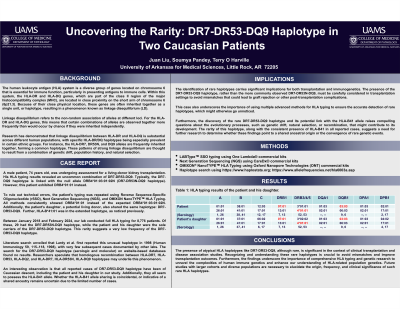Back

Uncovering the Rarity: DR7-DR53-DQ9 Haplotype in Two Caucasian Patients
(P608) Uncovering the rarity
Location: Platinum Ballroom

- JL
Poster Presenter(s)
Body: A male patient was undergoing assessment for a living-donor kidney transplantation. HLA typing results revealed an uncommon association, DR7-DR53-DQ9. Typically, the DR7-DQ9 haplotype is linked with the null allele DRB4*01:03:01:02N (DR7-DR53N-DQ9 haplotype). However, this patient exhibited DRB4*01:01 instead.
The patient's typing was confirmed using Reverse Sequence-Specific Oligonucleotide (rSSO), Next Generation Sequencing (NGS), and Oxford Nanopore Sequencing, all demonstrated DRB4*01:01 instead of DRB4*01:03:01:02N. His daughter shared the same unusual haplotype.
Literature search unveiled that Lardy et al. first reported this unusual haplotype in 1998, with very few subsequent cases documented by other labs. Researchers speculate that homologous recombination between HLA-DR7, HLA-DR53, HLA-DQ2, and HLA-DR7, HLA-DR53N, HLA-DQ9 haplotypes may underlie this phenomenon.
An interesting observation is that all reported cases of DR7-DR53-DQ9 haplotype have been of Caucasian descent, including the patients in our study. Additionally, they all seem to possess the HLA-B41 allele. Whether the HLA-B41 allele sharing is coincidental or indicative of a shared ancestry remains uncertain due to the limited number of cases.
Conclusion: Although the DR7-DR53N-DQ9 haplotype is almost ubiquitous when DR7 and DQ9 are present, the existence of the DR7-DR53-DQ9 haplotype should be acknowledged. Identifying the HLA-DRB4*01, rather than the DRB4*01:03:01:02N allele, for transplantation is crucial to prevent mismatches and post-transplantation complications.
The patient's typing was confirmed using Reverse Sequence-Specific Oligonucleotide (rSSO), Next Generation Sequencing (NGS), and Oxford Nanopore Sequencing, all demonstrated DRB4*01:01 instead of DRB4*01:03:01:02N. His daughter shared the same unusual haplotype.
Literature search unveiled that Lardy et al. first reported this unusual haplotype in 1998, with very few subsequent cases documented by other labs. Researchers speculate that homologous recombination between HLA-DR7, HLA-DR53, HLA-DQ2, and HLA-DR7, HLA-DR53N, HLA-DQ9 haplotypes may underlie this phenomenon.
An interesting observation is that all reported cases of DR7-DR53-DQ9 haplotype have been of Caucasian descent, including the patients in our study. Additionally, they all seem to possess the HLA-B41 allele. Whether the HLA-B41 allele sharing is coincidental or indicative of a shared ancestry remains uncertain due to the limited number of cases.
Conclusion: Although the DR7-DR53N-DQ9 haplotype is almost ubiquitous when DR7 and DQ9 are present, the existence of the DR7-DR53-DQ9 haplotype should be acknowledged. Identifying the HLA-DRB4*01, rather than the DRB4*01:03:01:02N allele, for transplantation is crucial to prevent mismatches and post-transplantation complications.
